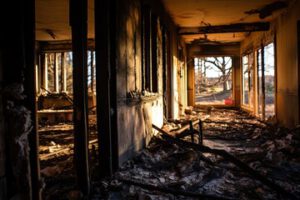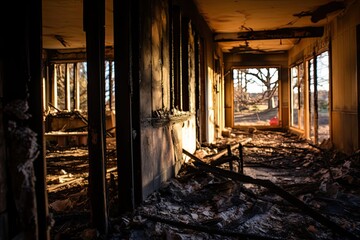Disaster restoration is the process of cleaning, repairing, and rebuilding homes and businesses after natural disasters or emergencies. It includes a variety of services, from water damage to mold mitigation.

Disaster restoration can be a difficult and time-consuming task. To help make the process easier, homeowners and property managers should take pictures of all damage and keep receipts. Click Here for more information.
When disaster strikes, it is important to have professionals on hand to help restore and repair the damage. They are skilled in their craft and are able to handle the job quickly and efficiently without compromising on the quality of work. They have a range of tools and techniques to do their job, and they work in a team to ensure that the job is done right. It is also important that they are insured so that you will be protected if something goes wrong during the restoration process.
There are many different types of disasters that can occur, and each has its own unique set of problems. Some can be catastrophic, resulting in widespread destruction of homes and businesses. Other disasters, such as flooding or fires, can be more localized and result in a smaller area of destruction. It is up to the disaster restoration professionals to identify the areas of damage and come up with a plan to repair it.
Disaster restoration services are an essential lifeline for people affected by natural or man-made disasters. They provide a range of remediation solutions, including water damage restoration, mold remediation, and structural repairs. They can also work in tandem with insurance providers to expedite the claims process and alleviate financial burdens.
The disaster restoration industry is a growing sector and requires specialized knowledge and expertise. A successful career in disaster restoration can be challenging but rewarding. There are many different opportunities to get involved, and it is important to stay on top of the latest trends and developments in the field. This can be done by reading trade journals and attending conferences.
One of the most important factors to consider when choosing a disaster restoration company is their ability to communicate well. This is especially important during stressful times, such as when a home or business suffers from severe water damage. A good disaster restoration company will keep you updated throughout the process and will respond to your inquiries in a timely manner. They should be able to answer your questions regarding insurance coverage and other details as well. They should also be able to provide an estimate before the work begins.
Tools
Disaster restoration requires the use of a variety of tools and equipment to clean up damage caused by natural disasters, chemical spills, fire, and more. The industry is constantly evolving and new technology has been developed to help restore areas quickly and efficiently. This includes specialized cleaning and decontamination tools like air movers, degreasers, hepa filters, sanitizers, and more. Those who work in the field also need to be prepared for safety hazards with protective clothing, gloves, and eye protection.
The first step in developing a new product is to identify and understand the needs of the market. The team at Restoration Tools identified the need for a tool to improve the efficiency of cleaning and decontamination on job sites. The solution they developed is called The Aerator, which is a small hand-held device that allows users to easily and precisely aerate the surface of materials to prevent oxidation and to remove mold and bacteria. The Aerator was developed in partnership with NIU EIGERlab and is now available for purchase online and through select retailers.
A disaster recovery plan helps companies prepare for unexpected events such as natural disasters, hacking, and other incidents that can cause data loss. The plan outlines policies and tools that protect the business from losing critical data. It also provides a backup and recovery strategy. This can be achieved through a combination of a physical backup in another location or virtual replication.
The restoration process can be time-consuming and involves coordinating with multiple stakeholders, including clients, insurance providers, and local authorities. This requires excellent communication and coordination skills. Additionally, restoration workers need to be able to adapt to unanticipated weather conditions.
Leveraging technology to streamline the disaster restoration process is critical for businesses. The right software can help you create and implement checklists and forms for quick inspections and quality assurance. For example, a low-code platform offers workflow automation and smart form builder features. It also lets you conduct layered process audits to identify and correct potential defects before they become major quality issues. It also helps you manage documentation and improve collaboration.
Training
There are many courses available for professionals looking to further their career in disaster restoration. These include the Certified Restorer program, which is a week-long master’s course in damage repair for experienced contractors and restorers. It teaches students to assess both buildings and personal property and addresses structural and contents recovery, remediation, odor removal, cleaning techniques, contracts and insurance. In addition, the course covers mold damage, restoration theory and other topics specific to the field.
Another option is the Disaster Recovery Professional (EDRP) certification. This course is based on the EC-Council’s information security and risk management framework and provides foundational training in business continuity and disaster recovery planning. It covers business impact analysis, assessing risks, developing policies and procedures and implementing a plan.
In addition to these specialized courses, there are also many more general classes for those working in the disaster restoration industry. For example, Servpro offers a series of online training programs for insurance agents, adjusters and franchise staff. The courses range from basic mitigation to water restoration and are a great way to expand knowledge and improve employee efficiency.
For those interested in the insurance aspect of disaster restoration, there are several specialized courses that focus on subrogation claims and mitigation reporting. Insurers need to have this knowledge in order to accurately assess damages, which will help them maximize their profits after a loss.
A number of community organizations exist for those who work in the disaster restoration field. These groups offer networking opportunities and a wide range of educational events that can be very beneficial to a career in this fast-growing field.
Continuing education is an important part of any career, and this is especially true in disaster restoration. There are many courses available to help you advance in your job, and some of them are even free! If you are considering a career in disaster restoration, consider getting involved with one of these communities to find out more about the latest trends and best practices in this fast-growing industry. This will ensure that you are always up-to-date with the most current and effective methods for restoring disaster-impacted properties.
Certifications
Disaster restoration is a highly specialized field. It takes a lot of knowledge to restore homes and businesses after floods, fires or other natural disasters. Many leading restoration companies have trained employees with certificates in specific areas of restoration. Some of the most common areas of training include: water damage, mold remediation and working with insurance companies. These certificates are important for the safety and quality of work of the employee and customers.
Getting certifications in the industry can also help a business. It can show that the business has met certain standards of quality and training, and that it follows a code of ethics. This is especially important in an industry that deals with the sensitive, sometimes emotional issues of property owners after a disaster.
Some certifications may have prerequisites, such as a certain number of years of working experience. Others may require that an applicant complete a specific course of study before being eligible to take the exam. Some of these classes are offered online, while others are taught in person by a certified instructor.
In addition to certifications, disaster restoration professionals should carry general liability and workers’ compensation insurance. This protects them in the event that a customer is injured or their property is damaged during restoration work. The insurance can also pay for the cost of a worker’s replacement should they be injured at work.
There are also many specialty classes offered that can boost a company’s credibility and improve its business. For example, there is a class called the Disaster Recovery Specialist (DRS) course that offers professionals real world Disaster Recovery/Business Continuity Planning knowledge to help them recognize and respond to risks. The class presents information on the latest risks and responses to disasters, and teaches students how to develop policies and procedures that will protect their organizations from threats and reduce recovery times.
Other classes focus on the business side of the disaster restoration industry, such as how to deal with insurance claims and large loss management. Continuing education courses are also available to keep professionals up to date on the latest trends, technologies, and best practices in the industry. Lastly, there is a new Disaster Recovery Specialist Program (EDRP) version 3 that introduces professionals to the latest concepts and methodologies for the protection and recovery of information systems and organizational processes from risks and vulnerabilities.
